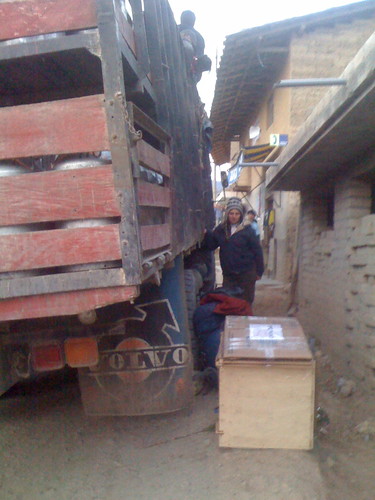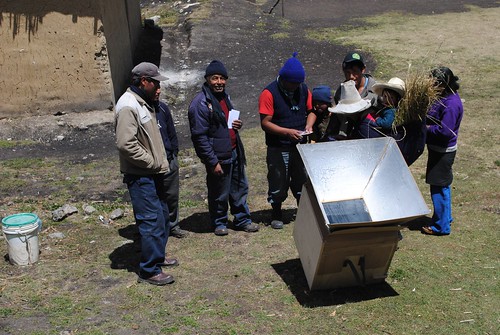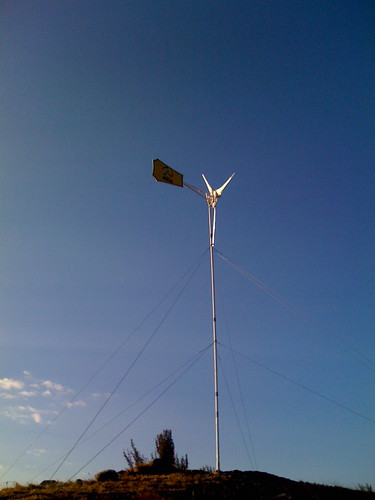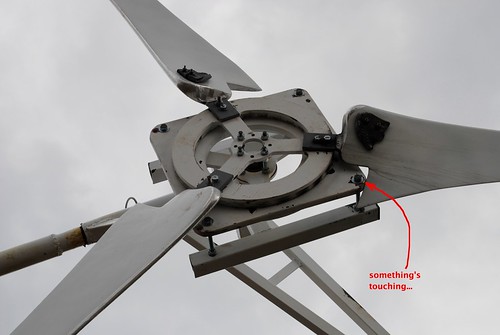Well, this time we reached the community by the same way its people do it – the lechera, the Gloria (Nestle owned) milk truck. The milk truck has one daily run from San Marcos to Nuevo Manzanilla, around 18:00-17:30. But we didn’t find that out until 17:00.
Well, to start at the beginning, our day begun in Cajamarca, one of the most beautiful mountain cities in Peru, after taking the bone shaking night bus (me and Yeara always sleep well, but Bart had a rough time with the shaky road). After a nice and expensive breakfast (with wi-fi!) at the modern-expensive hotel at the corner of the plaza de armas, we took the micro to the Inca baths (Baños de Inca). This is really the way every morning should start – a private big warm bath. Well – we defiantly needed this memory later that day… . After taking a look around these Inca Baths – which, for all the volunteers that were with us installing the turbine a month ago, is a different inca bath area then we went to before, much nicer in my opinion – we returned to the center of Cajamarca, after some lovely street food (frito mixto – sweet hot potatoes, a bit of pork, some cheviche on the side), and found the colectivo (a 14 people micro bus – just called micro usually) to San Marcos. 6 soles each, plus 5 soles for my over sized solar oven (it’s the box type – and i made this 0.6×0.6×0.6 m^3 box from ply wood). Incidentally, the Linea bus company from Trujillo wanted 20 soles for this extra package.
So we arrived at San Marcos at around 14:00, straight to the loving arms of Alex (our driver in our former visits), which quickly helped us secure two moto-taxis with our stuff to his house. Well, 14:30, we informed Alex that we plan on taking the milk truck and not hire his services (he was quite disappointed, understandably, since he’s unemployed, and hiring him to drive us in a 4X4 truck costs 250 soles). Alex said that the lechera leaves at 23:00, so we have time, to tour the town (San Marcos – ~10,000 people) and try to see if Victor is at home. Victor is the one that connected us to Nuevo Manzanilla in the first place, and he is our contact to the people of Nuevo Manzanilla. So we walked, bought some wood, for carrying the solar oven, at an incredible carpenters shop (pictures to follow), saw the football stadium (to which Bart commented “We don’t have that in our barrio!”), saw the mostly dry river, and around 16:45 ended up at Victors door step. Luckily. Since after a short conversation, some other guest arrived to Victor’s house, sat down, and after understanding our plans commented that the milk truck leaves at 17:30-18:00. Nice. The time was 17:30. So we ran for it! Victor said he will try to inform the community of our arrival by Radio Cajamarca (since they didn’t respond earlier), we took a moto taxi and fortunately caught the milk truck still picking up people, with the driver eating his dinner at comfort. Well, we understood that we had 15 minutes to return with our stuff (and the over sized solar oven box!) so we moto-taxied quickly to Alex’s home, emptied a shit load of stuff from our bags (oh – this is another misunderstanding of course. I was sure there were milk trucks that go all the way to Nuevo Manzanilla, but apparently they don’t do that any more. So we will have to walk 4 kilometers, and hence the emptying of our bags to the pure necessities. Like Camote chips!), Bart bought some food and we caught the lechera on time. On a lechera, the milk comes first. But to my surprise – there was a compartment on the bottom (the deck of the truck had two levels) where people (and our heavy solar oven) were sitting out of harms way. I guess you have to get early to get in there. We, on the other hand, sat on the top of the deck, on all of the big milk jars. It wasn’t that bad, until after an hours ride we found out that there was more cargo. 40 big wood logs, much longer then the truck started to get loaded on the milk truck. It’s already dark, and we’re now moving our bags from side to side, to make way for the logs. No, with all the milk jars, the height of the rail that one can hold on to was around 40 cm to begging with. With these logs – it’s gone. So for the first 20 minutes after the logs were loaded, me and bart were lying flat on the logs, holding to, well – the logs. And they don’t come with handles. Yeara managed to get a stop up front, but only after 20 minutes and the next stop did enough people get of for us to sit/stand in the front zone of the deck where there are more railings to hold on to. Well, it was cold, the stars were unbelievable, and it was cold. And finally, after 5 hours (loading the logs took about 45 minutes) we got to where the road splits to Nuevo Manzanilla, and… nobody was there. Well, Victor said that they listen to Radio Cajamarca, but, as we learned from the locals as well, they don’t always. So we changed to plan B, which was to hide the over sized heavily loaded (with a winch and heavy steel plates for connecting it to one of the wind turbine’s anchors) bloody solar oven, walk to Nuevo, and return tomorrow with Cirilo or Santos (The leaders of this community, who coordinated the work last time) to pick it up. Well, 4 kilometers, at 3800 meters, isn’t normally that bad. But this was 23:30 (23:45 by the time we finished hiding the oven), Bart didn’t sleep on the bus last night, and we never walked this road, let alone at a moon less night. So what i thought will be a 1 hour walk, turned into a almost 2, and we finally got there (after i declared “it’s the last turn, don’t worry!” about 4 times) at 01:30, woke Cirilo up (his house is closest) – who first called “James?” out of he’s bed btw (with the spanish pronunciation of course…) – and finally went to sleep.
The next day at 05:30 I went with Cirilo to pick up the solar oven. He insisted on carrying it on it’s back (see above in the flicker set pictures), while I led the horse with the winch and winch plate on it through the meadows back to his house. At 8:00 Bart and Yeara woke up and joined us to a beautiful day at Nuevo Manzanilla. The wind was blowing, the turbine was turning, and the sky was clear. The solar oven got to 114 C! We made rice, we planned a solar cooker building day for Saturday. The next day, Bart caught the 7:00 Lechera back to San Marcos, and the turbine stopped turning.
Well, the nice first day did include a lot of bearing squealing noises from the turbine, that weren’t there a month ago when we put it up. So i knew something was wrong. Could be the bearings, the bolts holding the bearing axis, the generators rotors (the part with the magnets that spin around) touching the stator (the stationary part, with the coils) because of “play” in the bearings, or anything else touching the stator while rotating. Well – luckily i’m here, and brought a winch with me – so we should be able to take it down and fix the problem, no? no. We don’t have the gin pole – a 3 meter pole that is needed to lift and lower the turbine, since we took it back with us to Trujillo after the installation. And Santos and the community didn’t understand the importance of this pole, so they didn’t buy one in the month that passed. So what to do? Well, first we enlisted Victor, to look for one in San Marcos. This was on our 3rd day there, while we were horse back riding to the market, on our way to Campo Alegro, to see another wind turbine battery charging project (ITDG made, 3 – 2 years ago, 20 systems of small wind and small solar for 20 individual houses. very impressive. pics below) . I also called James from the satellite phone at the market (yep – there’s a satellite phone at the market. The market is 2 hours walk, 1 hour by truck, from Nuevo Manzanilla, into the mountains. It makes economic sense – so it’s there.) to ask him to speak to Victor as well. While we where waiting to hear from Victor, we continued and had a very fruitful visit in Campo Alegro (James – we need to get intouch with ITDG. they can help with the maintenance, since they’re already doing it for campo alegro)
But, by the end of the day we heard back from him, realizing that a 2.5” steel tube could not be found in San Marcos. What to do? Santos arranged a meeting that night with the community people, saying to me that they will send someone to Cajamarca tomorrow. But (again…) when he got back later, he said that it didn’t occur to him earlier, but it’s Saturday tomorrow, and the stores in Cajamarca are only open until noon, and the lechera that goes to Cajamarca – the fastest (and cheapest) way to get from Nuevo to Cajamarca – gets there after 13:00 … So finally, Santos suggested that we use a combination of thinner and shorter metal rods, and a wooden pole, with some rope, as the gin pole. Why not! So we tested it, and what can I say – it worked just fine!
Taking down the turbine though was not a straight and simple task. Not that i didn’t have a new winch, and a designed a nice way to connect the winch to the anchor we already have. I just miscalculated and connected a to short cable… so when the turbine was about 4 meters above ground we changed tactics and resorted to good old human force (and a ladder. It just appears in these situations). The winch and the winch connection did a fine job, so for the next lowering of the turbine (long life = maintenance) we corrected the length of the winch cable, and this should be a quick and easy job.
When the turbine was almost down the problem could already be seen – one of the blades root (the “extra” piece) was touching the corners of the stator (the part with the coils). This made me very annoyed, since that part has no aerodynamic meaning. It just looks good. Or so i thought. Because when i could look at the blades more closely, i noticed the real cause for the problem – one of the blades connecting bolts got a bit loose, so the blade could move, and therefor touch the corner of the stator. So these “extra” bits on the root of the blade actually acted as protection in case the nuts came a bit loose. With out them – no doubt we’d have flying blades! Of-course, the blades bolts have no business getting loose in the first place. Well, i tried to tighten them – and the thread took all the force i had, and what Santos had to offer as well. I didn’t have a torque meter, but i can say for sure that the thread was not the problem. So why did they open? Wind turbines vibrate. I normally put double nuts on anything, with lock tight. These bolts didn’t have that benefit, and instead of lock tight we used thin zap (not such a bad replacement all in all, but apparently not for this blade set). Additionally, we had problems with the threading, so perhaps the force we applied wasn’t enough – for a good reason at the time, we weren’t sure if the threads will take it. Well, now the turbine is back up and running, and for the next week at least i instructed Santos to have somebody watching it every couple of minutes, and if he hears the noises we heard in the first day of this trip – put the break on.
The nights were long, full of starts and dreams. And weird noises. What the hell were these noises?? well, the night after we fixed the turbine, around 2 am Yeara finally convinced me that the noises were the bed falling apart. So we got up, and moved the mattress to the floor… (just barely enough space for that) This bed was made for one small Peruvian, and not to small Israeli’s (who knows what would have happened if Santos invited one of the volunteers to sleep there… (all above 1.80 m).
The last day, the day after fixing the turbine, was spent building solar ovens with Santos. It wasn’t a good day for actual solar cooking, because of all the clouds, but the insulation of the solar cooker’s box, with the strong sun in between the clouds, did manage to sustain an above 80 C in the oven (the minimum cooking temperature recommended by solarcooking.org)
Aditionally, I added a simple watt-hour meter on the AC side of th system, that is – measuring the consumption of the school and what ever else they have. That will let them see the amount of energy theyre using, and i showed and asked Santos to jeep up a log book of battery voltages (individual batts) and the consumption every day, with some other indicators. That and the fixed controller, are shown in the pics below.
And other then that, I spent quite a bit of my breakfast launch and dinner trying to record and film cuy sounds, here is my best recording – cui sounds will always make me think of nuevo manzanilla (5$ for the whole disk, promotion special)






